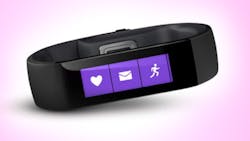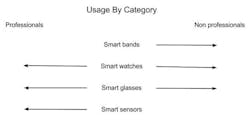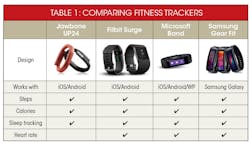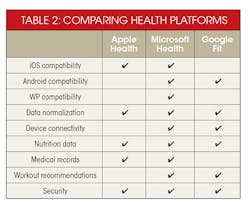The Wearable’s Role in the Modern Healthcare Industry
This file type includes high resolution graphics and schematics when applicable.
Even though many of the existing wearables reached the market decades ago, some of the equipment was either hard to use or intrusive. Today’s wearables with built-in sensors and multiple functions are revolutionary in personal medicine. Not only do they save thousands of lives and provide doctors with more comprehensive insights into their patients’ condition, they also save business costs and accelerate time to market (read my recent post about Wearable Technology in Healthcare and Enterprise for more details).
To better understand the complexity of the healthcare wearable-technologies market, let’s categorize wearables and define their target users. Today’s smart devices generally divide into the following groups:
• Smart bands (activity/fitness trackers)
• Smart watches
• Smart glasses
• Smart sensors (ingestible sensors)
Correspondingly, the target users of the Healthcare wearable devices fall into two main categories:
• Medical professionals
• Non-professional users (homecare patients, aftercare patients, senior care)
The figure below illustrates how the target audience and the devices they use correlate:
Today’s market provides a variety of gadgets already approved by the FDA. Of course, the market titans such as Google, Samsung, and Apple have not been left behind. Samsung launched a promising project based on the open platform Simband for the development of smart apps for healthcare. Google announced Google Fit SDK, an open platform that lets users control their fitness data. Apple is currently working with two new tools: HealthKit as a health data-tracking platform for developers, and dashboard application Health that’s pre-installed by default on every device running iOS 8. The market for Activity trackers also continues to offer new trackers with extended functionality, coming by way of Jawbone, Fitbit, and others.
Fitness Trackers and their Functionalities
Two of the main market players in this space—Fitbit with its six smart bands for different purposes, and Jawbone with its UP and UP 24 smart bracelets—provide software development kits (SDKs) and APIs for simple app development and integration into almost every platform, including mobile, web, and desktop support.
Microsoft and Samsung offer more advanced fitness trackers with the Microsoft Band and Samsung Gear Fit. While Samsung’s smart band connects only to Galaxy devices provided by the vendor, MS Band works with all platforms, including Windows Phone, Android, and iOS. What’s more, MS Band works with the new Microsoft Health platform (see Health Platforms section below).
All of the platforms can collect health data such as daily step count, sleep duration, calories, heart rate and a lot of other useful health data (Table 1). Some of them collect data continuously (like Microsoft band and Fitbit Charge) while others don’t have that ability. Nonetheless, the principle of how these gadgets work and the information they collect represents a great leap for medical data analysis. Of course, the benefits for healthcare and insurance industry made possible by such analytics could save millions of dollars. Most importantly, though, they’re able to predict and prevent serious health problems—and potentially save millions of lives.
Wearables’ High Point: Smart Watches
This year definitely symbolizes what can be considered the golden age of wearables, particularly with the unveiling of an entirely new gadget family called smart watches. Being easily integrated with smartphones/tablets, some watches can even work independently without any proxy, like phone or tablet that serves as an entry point to watch communication. With the rapid growth of this market, there’s no doubt that smart watches will be more tightly connected with healthcare than activity trackers.
Possessing all of the data-collection features of fitness trackers, smart watches may extend this functionality through a third-party application that could be simply developed with vendors’ SDKs. If smart bands serve as health data-collection gadgets for different purposes (primarily for non-professionals), smart watches — with their possibility to run third-party applications — can quickly take their place on the professional front.
With such tech giants as Google, Apple, Tizen, and Pebble presenting their platforms for smart watches, the world expects further announcements from Apple and Microsoft.
Health Platforms
Available from leading technical companies like Microsoft, Google, and Apple and supported by all mobile platforms (Windows Phone/Android/iOS), health platforms facilitate a simple process of health data collection from different sources into one place for sharing with different professional EMRs — EHR systems or directly with patients’ personal doctors or relatives.
The following platforms support the Health Insurance Portability and Accountability Act (HIPAA) that’s mandatory for applications used to collect and sharing user’s private health data (Table 2):
• Health Vault and Microsoft Health by Microsoft
• Google with Google Fit
• Apple and Apple HealthKit
Microsoft provides a number of opportunities to support Microsoft Health and HealthVault in terms of data collection and storage in the cloud. As a result, it establishes these platforms as a trusted place to store health information and share it with medical professionals on a security-enhanced basis.
This file type includes high resolution graphics and schematics when applicable.
Even though these platforms are isolated, they’re still set to achieve the next level—the ability to unify all data and democratize it, which will add a real value to all existing functionalities.
Conclusion
Due to wearable devices’ multifunctionality, they may quickly become a highly valuable tool for the healthcare industry in terms of data visualization and data analysis. When wearables are used by patients to continuously collect and share their health data with doctors or hospitals—allowing providers to analyze patient health data on the go—these gadgets will usher in a new era in preventive medicine.
About the Author
Oleksandr Matviishyn
Research Engineer
Oleksandr Matviishyn, Research Engineer at SoftServe Inc., has four years of experience in mobile, web, and cross-platform development. Along with research related to mobile and cutting edge technologies, Oleksandr also works on healthcare-, enterprise-, and security-oriented solutions and is a regular contributor to the SoftServe United blog.





